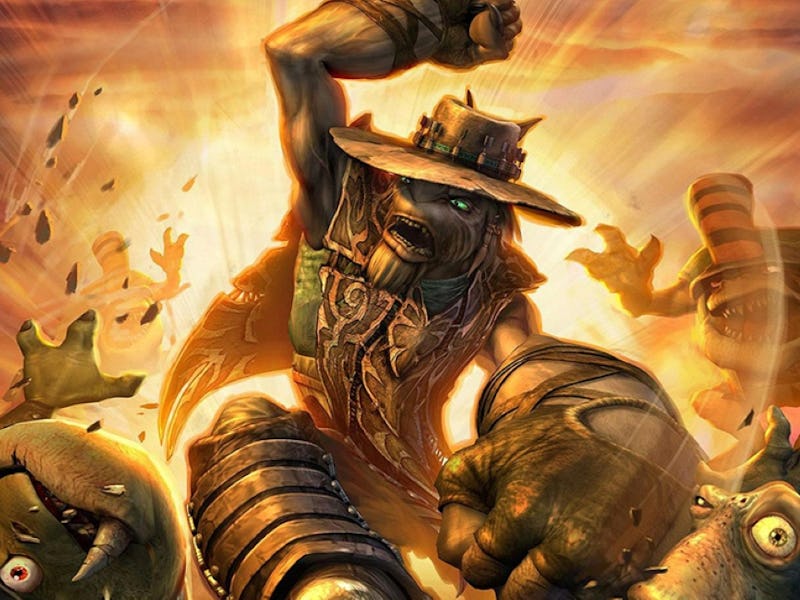20 Years Ago, One Legendary Franchise Changed Perspectives, Literally
‘Oddworld: Stranger’s Wrath’ jumped past platforming into a hybrid FPS adventure.

Gaming in the ‘90s was full of weird little guys. Earthworm Jim. Wario. ToeJam & Earl. The list goes on, but the one constant is that the graphical advancements of ‘90s gaming hardware meant artists and designers could expand the visual palette beyond pixelated humanoids and vehicles. One franchise, in particular, turned the weird dial up to 11.
In 1997, Oddworld: Abe’s Oddysee introduced gamers to Abe, a lovable, lanky green alien slave who escapes his captors and becomes an unlikely hero who saves his people from becoming processed food. With his bulbous Bambi-eyes and strange language, Abe became an overnight sensation that spawned a franchise. And twenty years ago, that franchise took a bold turn that still reverberates today.
Released in 2005 for the original Xbox, Oddworld: Stranger’s Wrath marked a departure from the formula that had defined the Oddworld series up to that point. Known for its puzzle-platformers featuring quirky, downtrodden protagonists like Abe and, in later games, a fellow Mudokon named Munch, the developers at Oddworld Inhabitants took a significant gamble. They shifted gears to create a hybrid action-adventure title blending first-person shooting with third-person exploration. This risk resulted in a cult classic that is still remembered fondly by fans and critics alike — a testament to its innovation, charm, and technical prowess.
The development of Stranger’s Wrath was as ambitious as it was tumultuous. Oddworld Inhabitants, led by the visionary Lorne Lanning, wanted to push boundaries and create a unique experience that married the cinematic qualities of their previous titles with more dynamic gameplay. The protagonist, Stranger, was a far cry from Abe’s reluctant heroism. A rugged, mysterious bounty hunter with a secret, Stranger embodied the game’s tonal shift toward a Western-inspired narrative.
The gameplay itself was equally daring, combining the environmental exploration and platforming that Oddworld fans loved with fast-paced combat mechanics. The game’s signature weapon, a crossbow that fires live ammunition in the form of small creatures, exemplified the studio’s commitment to creativity and humor.
Exploring the open world in third-person gave developers a chance to create a sprawling Wild West-inspired epic.
Innovation rarely comes without challenges however, and Stranger’s Wrath faced an uphill battle from the start. Financial pressures and publisher interference forced the developers to cut content and release the game exclusively on the Xbox, limiting its initial reach. While the game received glowing reviews for its originality and design — including an 88 on Metacritic — it suffered from disappointing sales. Many critics praised the fluidity of its dual-perspective gameplay, the lush environments, and the character-driven story, but the lack of marketing muscle from publisher EA hindered its commercial success.
Over time, however, Stranger’s Wrath developed a dedicated fanbase. Its combination of unique gameplay mechanics and memorable world-building ensured that it remained relevant in gaming discussions long after its release. In 2011, an HD remaster brought the game to new platforms, including the PlayStation 3 and PC, introducing it to a new generation of players. The remaster was lauded for its improved visuals and refined controls, further solidifying the game’s legacy.
First-person shooting was a departure from the puzzle platforming the franchise was known for, but fans and critics alike embraced the shift.
The influence of Stranger’s Wrath can be seen in several aspects of modern gaming. Its seamless blend of first- and third-person gameplay predated similar hybrid mechanics seen in later blockbusters like The Elder Scrolls V: Skyrim. The departure from traditional platforming may have made EA skittish about marketing something so different, but its clear in hindsight that the developers were ahead of the times.
The game’s inventive use of live ammunition mechanics and its commitment to character-driven storytelling also paved the way for indie developers to take greater risks in blending humor with innovative gameplay concepts. Studios like Insomniac Games and Double Fine Productions have cited Oddworld’s creativity as an inspiration for their own works.
Oddworld: Stranger’s Wrath stands as a testament to the importance of creative risk-taking in the gaming industry. While it may not have achieved the mainstream success its developers hoped for, its influence and legacy stand strong to this day. Weird little guys remain undefeated.